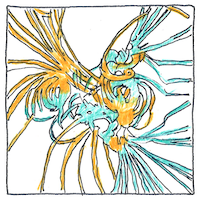Motonori Matuyama
plate tectonics

|
Geomagnetic reversals
Compass needles point north although they wouldn’t have always. Fixed in molten rock, the magnetic orientations of basalts was confusing; people had found rocks with the opposite polarity; so scientists supposed that the magnetic field of the earth had once reversed. Motonori Matuyama gathered basalt samples in Manchuria and Japan and was able to show a correlation between the magnetic orientations and the position of the rocks in the strata. It turns out the magnetic polarity has flipped many times in the distant, distant past.
Sea-floor record
Symmetrical parallel stripes on each side of the mid-ocean ridges oriented magnetically north, then south show that the sea floor has spread and that the polarity of the earth’s magnetic field has reversed at random many times written in the sea floor as on a scroll.
Disorder
The earth’s magnetic field is not as simple as a bar magnet’s. During a reversal, temporary knots of alignments turn about at different times. Like a creative process, characterized by disorder and confusion, one can not predict the progress or conclusion of the transforming process only after which it might seem that reason has prevailed.



Motonori Matuyama’s proof generated little interest at the time; however, it became more significant in the late fifties when studies of continental drift and sea-floor spreading required an understanding of geomagnetic reversals. Today, the most recent reversal is named after him.
See also in The book of science:
Readings in wikipedia: